
Barber County Kansas

 |
Barber County Kansas |
 |
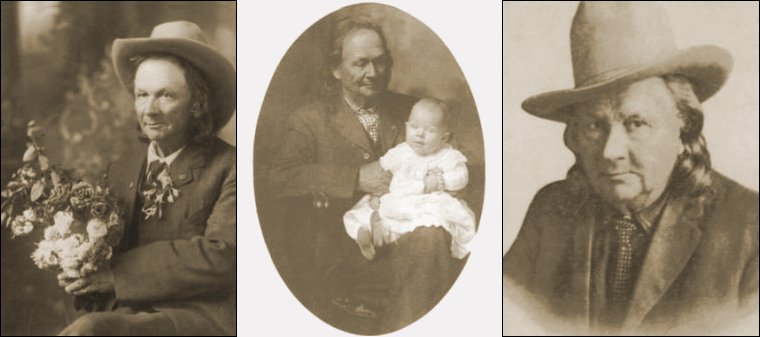
Pilgrim Bard by Scott Cummins
To whom the green sward is like bed of down,
With no pavilion save the starlit sky,
Upon whose locks the evening dews have shown;
Who often slept among the wilds alone,
The while the coyotes sing his lullaby.Gladly would I backward turn Time's mystic wheel,
And make this land again a desert wild;
I care not what the future may reveal;
But memories of the past will o'er me steal-
Again I would be nature's reckless child.
Orange Scott Cummins
Photo used with permission of Linda Wagner,
webmaster of OkieLegacy.org.
See: Scott Cummins, "Pilgrim Bard."Orange Scott Cummins, "The Pilgrim Bard", was a "traveling man". He was born born on 12 May 1846 at Zenia, Harrison County, OH., to Reverend George Irwin Cummins, (of Washington, MD) & Mary Ann (Clyde) Cummins (from Kent County, Delaware). He moved with his family to Suasqueton, IA, when he was 18 months old. His family lived in Centerville, OH, when he was discharged from the U.S. Army on 8 Aug 1863; he was enlisted at Drakeville, IA, in 1861 and served in the Civil War for over 3 years.
He served in Company A, 3rd Iowa Cavalry, according to an article, "Soldier's Reunion", published in The Medicine Lodge Cresset, October 23, 1879.
O. Scott Cummins married Mary Melinda Martin (born 27 Oct 1848, Hendrix Cty., OH) in Appanoose Cty., IN, on 4 April 1865; they then resided on a farm given to them by her father, apparently as a dowry gift.
An excellent biography for him is online: Orange Scott Cummins a.k.a. The Pilgrim Bard, May 12, 1846 - March 24, 1928.
The electriccemetery.com biography states that "In 1869, Scott and Mary went to Kansas to visit his family who had moved there."
It is likely, but not certain, that these relatives may have been the W.B. & Louella Cummins family. No doubt this question could be answered fairly quickly with more research into it.
By 1870, O.S. Cummins was operating "The Frontier House" hotel in Wellington, KS, was the Justice of the Peace, and considered to be one of the city founders.
In 1877, Scott Cummins apparently decided to break ties with Iowa to become part of Barber County, Kansas. It is probable, though not proven, that he had been a Kansas resident for at least seven years. Whatever the case, he traded his farm in Appanoose County, IA, for a stock of horses and cattle in order to take his wife, who suffered from inflammatory rheumatism, to a "higher, drier climate". They settled in or near Lodi, southwest of Medicine Lodge.
The mention, in the electriccemetery.com biography, of him having been appointed a U.S. Marshall and of having stored an arsenal in his home, "built in the bank dugout fashion", is certainly a lead any responsible biographer will want to follow in their accounting of his life.
It is less surprising of the Pilgrim Bard to learn that he soon moved, within two years, to a new town called "Last Chance" southeast of Medicine Lodge about 18 miles.
The new Post Office established for this town, Canema, was named after Scott and Mary's daughter, Nina Canema Cummins. Canema was locally known as "Cumminsford" and was located on on Little Mule creek in Barber county, 12 miles south of Medicine Lodge.
Scott Cummins was living at Cumminsford on 23 April 1885 when he wrote The Flood, which was published in The Medicine Lodge Cresset on May 7, 1885. This poem is about the Great Flood of April 21, 1885, in Barber County, Kansas. At least 18 people perished in the flood.
According to The Kansas Gazeteer & Business Directory For 1888-1889, Mary M. Cummins lived in Canema, Barber County, Kansas, and ran a grocery and hotel. The electriccemetery.com biography states: "Many cattlemen and cowboys stopped for meals, lodging and supplies as Last Chance was located on the old cattle trail from Fort Supply, Oklahoma Territory to Honeywell, Kansas."
Nina Canema Cummins married a cowboy, T.J. Dyer.
After leaving Barber County, Scott Cummins is known to have lived in Nescatunga and Coldwater, Comanche County, Kansas.
He was living in Winchester, Oklahoma, when his wife, Mary M. Cummins, died January 24, 1903. (Her obituary was published in The Barber County Index, January 28, 1903.) The news of her death was carried to Medicine Lodge by Denver Boggs, another former Barber County resident was settled near Winchester, Oklahoma.
Apparently seeing greater opportunities to the south, Scott Cummins took part, on 16 Sept 1893, in the Oklahoma Land Run and staked a claim in the Cherokee Strip. The claim, 7.5 miles west and 3 miles south of Hartdner, KS, was on the Salt Fork River, and the family's first dwelling was a dugout. The Cummins farm house near Winchester, OK, in which his wife probably died was built at a later date.
Judging from the fact that Mary M. Cummins was buried in a family plot on a hill just north of that homestead beside Scott's mother, Mary Ann Cummins, it seems that his mother had been part of their Oklahoma household.
Civic duty called to Cummins again after moving to Woods County, Oklahoma: for 6 years he was a U.S. Land Commissioner and for 4 years he served the District Court of Woods County as a baliff. Scott Cummins died 24 March 1928. He is buried at the Alva, Oklahoma, Municipal Cemetery.
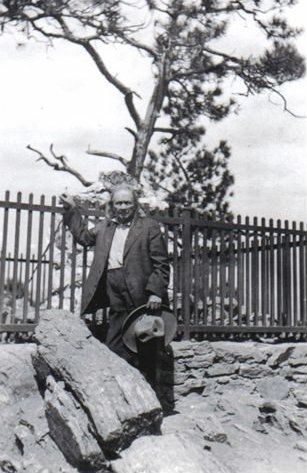
The Chosen Land - Barber County, Kansas, pg. 146.
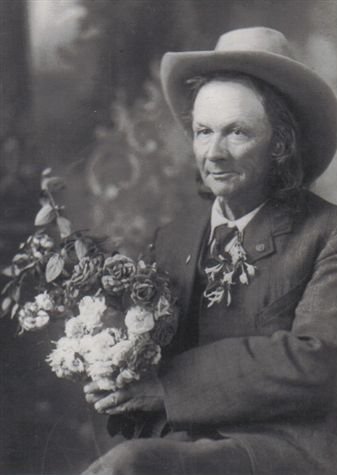
Orange Scott Cummins
By Joy (Cameron) ShermanO. Scott Cummins, the Pilgrim Bard, was born May 12, 1846, at Zenia, Harrison County, Ohio. His father, Rev. Geo Irving Cummins, a native of Scotland, and his mother, Mary Ann Clyde Cummins, from Ireland, were married in Scotland before coming to America.
Rev. Cummins, a Methodist preacher for 55 years moved frequently as the church conference directed. When Scott was 18 months of age, they moved from Ohio to Northern Iowa. Most settlers were Indians of the Mesquoquie tribe. Many of his playmates were young Indians. He learned their customs and habits. From these associations he wrote "The Legend of Cone."
Scott enlisted for the vicil War at Drakeville, Iowa, in Co. A 3rd Iowa Calvary in 1861. He participated in all the battles of Gen. Wilson's Calvary Raids. He was mustered out August 8, 1864.
On April 4, 1865, in Appanoose County, Iowa, Scott married Mary Melinda Martin, born October 27, 1848. A daughter, Nina Canema, was born on the farm given to them by Mary Melinda's father.
While visiting Scott's family, now living at Paola, Kansas, a son Rolland was born, but lived only a few months. They returned to Iowa, adopted a three year old orphan brought in from New York. He was named Dugan for an old war buddy.
In 1870 Scott was recognized as a founder of Wellington, Kansas. He was a Justice of the Peache and proprietor of 'The Frontier House', Wellington's first hotel. They returned to Iowa because of Mary's health, and Daisy Lorn was born. Doctors advised higher, dryer climate for her rheumatism, so they returned to Paola, with 3 covered wagons, driving cattle and horses.
Mary Melinda and Scott went on to Barber County and staked claims near Lodi, returned to Paola for the winter. In the spring they began a six weeks trip to Lodi, a store and post office southwest of Medicine Lodge.
Scott was appointed U.S. Marshall and given an arsenal to be used for protection of settlers from Indians. They were stored in his dugout home.
Two years later, they moved 5 miles from the first claim, now 18 miles southwest of Medicine Lodge, a place called 'Last Chance. The Mule Creek crossing was called "Cummins Ford". The Cummins family operated a general store and lodging house and served meals. 'Last Chance' was on the cattle trail from Ft. Supply to Honeywell. It was later named Canema for little Nina Canema.
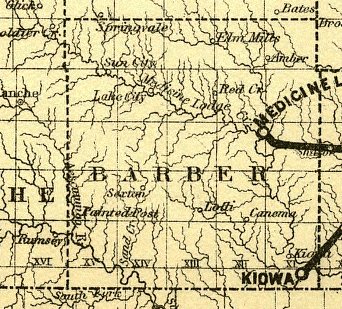
1886 map of Barber County, Kansas, showing Canema.
Three sons were born, Walter Scott, who died in a flu epidemic; Donald DeWitt (Dewey), who died September 22, 1969, and Dwight, who died soon after birth.In the Cherokee Strip Run, Scott staked a claim on Salt Fork River, 3 miles south and 7 1/2 west of Hardtner. They built a lovely farm home near the original dugout - near Winchester, Oklahoma.
Mary died January 24, 1903 and was buried on a knoll near Scott's mother, Mary Ann, on the home place.
Scott continued to live at his home where he wrote 'Musings of the Pilgram Bard," "Owaaneo" (Pale Flower), and "Twilight Reveries". His writing was encouraged years before by Tom McNeal, founder of "Medicine Lodge Cresset," later with Topeka "Mail and Breeze."
Scott presented a rough exterior, but was deeply spiritual, due to early training and his own Bible reading. He was a concerned, compassionate, warm, and loving person. He prefered the quietude of home and friends.
On March 24, 1928, he died and is buried in Alva Cemetery.
"About June 1884, in order to attempt a consolidation of the two interests, and avoid a county seat fight, some one or more called a meeting which was held at Coldwater, mostly on the prairie, as there was not enough room in Sisson's office to hold the crowd, to make a treaty of peace. Among those who were up from our rival town of Nescatunga was Scott Cummins, now of this county, and town, and wearing the nom de plume of "The Pilgrim Bard."
-- J.P. Grove: Memoirs of Early Comanche County, Kansas,
The Western Star, March 4, 1921.
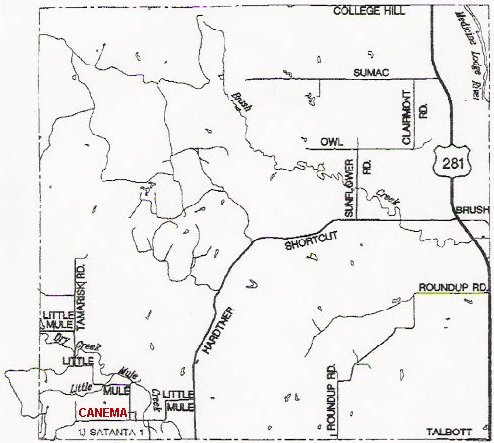
Map showing the location of Canema,
a.k.a. Cumminsford, Barber County, Kansas.
From the map collection of
Phyllis Scherich.
Meanwhile, Scott Cummins, the "Poet Bard" who ran his Last Chance tavern-trading post on the nearby Little Mule Creek canceled his Fourth of July celebration -- a victim of one too many sabbaths.
"Cumminsford will not celebrate the Fourth of July this year for various reasons," he declared. "One is that the 4th falls on the Christian Sabbath, and if we celebrate it on the 3rd, it's on the Ancient Jewish Sabbath, and if we celebrate it on the 5th it would be a day too late and no use to make a fuss about it. Therefore, we'll give way and let the small towns bust themselves."
-- Chapter IX - Hebron and Gilead: Gyp Hills Jerusalems, Sod Jerusalems, by Lloyd David Harris.
He (James M. McCay) came to Comanche County in 1884 with a cousin, Kerry Kendall. The two men brought their grubstake in a covered wagon via Old Kiowa where Scott Cummins, the poet, had a store called "The Last Chance." Deerhead had just been started.
-- James Monroe McCay, Comanche County History, published by the Comanche County Historical Society, Coldwater, Kansas, 1981.
Scott Cummins was one of the Kansas authors pictured in a portrait album exhibited as part of the Kansas Exhibits at the 1893 World Columbian Exposition.
Musings of the Pilgrim Bard, a book by Scott Cummins.
A MEMORIAL POEM, from Musings of the Pilgrim Bard, by Orange Scott Cummins.
The Union, March 23, 1888. Scott Cummins has a poem in last week's Medicine Lodge Cresset, which was written as a tribute to the memory of Capt. Byron P. Ayers.
The Flood -- The Medicine Lodge Cresset, May 7, 1885. This poem by The Pilgrim Bard is about the Great Flood of April 21, 1885, in Barber County, Kansas. At least 18 people perished in the flood.
Memorial Tribute by the Pilgrim Bard to the Memory of Capt. Byron P. Ayers -- The Medicine Lodge Cresset, March 15, 1888.
Lines, a poem from Musings of the Pilgrim Bard by Scott Cummins, "Rehearsed at the "Old Settler's Picnic in Paddock's Grove on Upper Elm Creek, Barber County, Kansas, September 16, 1886, on the grounds where Esq. Paddock and his entire family drowned in the flood of 1885."
A Christmas in the Wilderness, 1871 by Scott Cummins. A story about some buffalo hunters' Christmas dinner near where Medicine Lodge, Kansas, was later established.
Cummins, Scott. Reminiscences of the Early Days: Barber County, Kansas. Kansas City, MO: Press of Ramsey, Millett & Hudson, 1886. (K978.1/-B23/Pam.v.1/no. 3).
-- Bibliography for Barber County, Kansas, The Kansas State Historical Society.
Other books by Scott Cummins: Owaaneo (Pale Flower), Twilight Reveries and Musings of the Pilgrim Bard.
Reminiscences of the early days: Being a true history of the trials of an illfated emigrant train bound for California, who were held captive among the ... now embraced in Barber County, Kansas. Press of Ramsey, Millett & Hudson, 56 pages, 01 January 1886.
Musings of the Pilgrim Bard: A Book of Poems by Scott Cummins. The book includes Maid of Barber, a poem inspired by an early Barber County cowboy named Walt and a Barber County maiden named Malena.
After the Fire is a poem written by Scott Cummins on July 5, 1893, the night after his home at Canema burned down.
Tom McNeal on the Cresset
Medicine Lodge Cresset, April 20, 1890.
Scott Cummins - Soldier, Bone Peddler,
Adventurer, Poet and Maker of Own Legend
By - Joan Wagner Hodgden
[This article originally appeared in the Alva (Okla.) Review-Courier Progress Edition 1972.]
We know about the virtues that a pioneer must have: a love of adventure, courage in the face of adversity, adaptability, perseverance and just plain grit. But we sometimes leave out a characteristic many of them possessed in a great degree, namely sensitivity to the things around them. This is often revealed to us by a line in a diary; a phrase in an old letter; or a few words scrawled in a bible.
On of Alva’s early settlers left us a whole book revealing his awareness of our mutual surroundings. This man was Scott Cummins, soldier, farmer, adventurer, bone peddler, and maker of his own legend as the undisputed poet of these plains. When he made the Run into Woods County on September 16, 1893, settling near the community of Winchester, Scott Cummins had already been a successful farmer and rancher from the Medicine Lodge area, and an early developer in several Kansas communities. He also had won the reputation as a “Pilgrim Bard” of that area, but the spirit and love of adventure that had impelled him during his past career also brought him here to help open the Cherokee Strip.
Orange Scott Cummins was the son of parents imbued with a sense of mission. His father, a Methodist minister named George Irving Cummins, was a native of Scotland, and his mother, Mary Ann Clyde Cummins, a native of Ireland. They married in Scotland and left for the United States, where they were to spend 55 years in the ministry moving around the new, and sometimes-raw American West. Scott was born in Xenia, Harrison County, Ohio on May 12, 1846, but went with his parents as a toddler to northeastern Iowa. It was here in a small frontier village that Scott not only met his first Indians, but also grew up with them, playing their games, learning their customs, and obviously loving every minute of it. He was so taken with the glamour of Indian life that he afterwards incorporated these Indian friends, last survivors, he claimed, of the Mesquoquie tribe, into a romance, which he later claimed as his own. The hero of this tale was Cono, a gallant Indian Chief who, upon hearing of the tragic loss of a baby son by a white woman of the settlement, left on her doorstep a little Indian papoose to be raised as her own. Cummins liked to think that he was that baby, and even in later life affected the dress of the Indian frontier scout.
Scott’s growing up took place during times of trouble and change in the United States. He was only fifteen years old when the Civil War started. Nevertheless he tried to enlist immediately in the Union Army, but was refused until he reached the ripe old age of seventeen. In February of 1864 he was taken into Company A of the 3rd Iowa Cavalry. His Civil War exploits included volunteering for dangerous scouting duty behind enemy lines. Perhaps his early Indian games helped him here, and he said that at times the Union uniform was not the only one he was obliged to wear.
After the end of the war and mustering out, he married Mary Melinda Martin in Iowa, but soon left that state to settle in Kansas where his parents had been sent in another step in their long journeying for the Methodist ministry. Scott Cummins was to be an influence in several Kansas communities, but was perhaps most active at Wellington, Kansas, where as one of the early developers he served as Justice of the Peace and was also for a time the proprietor of the Frontier House, Wellington’s early hotel. However, when his parents were sent into less settled Barber County, (Kansas) Scott and his wandering spirit followed to the area where both challenge and fortune beckoned. It was in Barber County that he was to find contentment and fame as a poet.
In 1874, after a decade of wandering, including the war, Cummins settled in Barber County near the post office of Lodi. Times were hard; these were years of depression and panic, of arguments over gold or silver currency, and nature was also hard, sending years of drought to farmers just wanting to make a start. The Indian raids were not over, either, and it took a good deal of courage not to mention just plain stubbornness to stay in such a country. Cummins stayed and was named U.S. Marshall there. In the back of his dugout was a room dug into the bank behind it where he stored the arsenal of guns to be used by the settlers during an Indian raid. He obtained from a disgruntled settler a claim about five miles from Lodi by trading for it a team of horses and a corn planter he had picked up somewhere. The hard times convinced him that a corn planter would never be of use in Kansas. The old settler took out and Scott settled down to make a living for his family on the farm by Mule Creek. Grandfather Cummins when asked to comment about Scott’s move, responded by naming the cabin he built there “Last Chance” - the last chance (then) for a settler to get a good hot meal on his way west.
To make a living, Scott had to do more than just work on the farm, and so he became a Bone Pilgrim, a gatherer of old buffalo bones, undoubtedly, a profession unique to the Western Plains. The great slaughter of the American Bison, or buffalo, had already taken place, and their bones were left to bleach on the prairie. These bones made good fertilizer when powdered, and burned. Powdered bone ash was also used in ceramics and in cleaning and polishing compounds. It was this gathering job that gave Scott time to observe and respond to the scene around him, and which also took him down into the Cherokee Outlet (popularly known as the Cherokee Strip) to find the ones there. He became familiar on these trips with the Woods County area, and it was here when camping at night, perhaps on Eagle Chief Creek, that he would by the light of campfire and moon put down his thoughts and poetry. He wrote on the materials available - the broad blade of a buffalo knife, or even a piece of soft, flat gypsum. He rarely, if ever, even before publishing, altered or corrected a piece.
These musings came to the attention of a Medicine Lodge newspaper editor, Tom McNeal, who not only printed them, but also encouraged Scott to publish. It was he who renamed Scott, who usually referred to himself as just a “Bone Pilgrim”, as the Pilgrim Bard”, a wanderer who sang the praises of the nature he loved. Scott’s volume of poetry, published in 1903 when he was living at Winchester, Woods County, was to be titled “Musings of the Pilgrim Bard.” A copy of this book was presented to President Theodore Roosevelt, and he, a long time enthusiast for the West, wrote of his approval and delight in the volume.
Scott Cummins’ adventurism spirit might have led him to join the Run of the great opening of the Cherokee Strip even if he hadn’t suffered from an unfortunate occurrence at this time, but the Run must have proved irresistible coming just when it did. On July 4, 1893, while the Cummins family was away celebrating the 4th in the usual picnic style at Mann’s Grove, Kansas, the family’s home and possessions burned to the ground. A firecracker probably started the fire. The loss included the poet’s manuscripts, his historical notes, relics and library, and so was a double blow.
Cummins and his son-in-law, Tom Dyer, who had been a cowboy for the Gregory Eldred Ranch Company, were familiar with the Cherokee Strip country, and Dyer had even surveyed the country in 1891 with the purpose of picking out a location to settle when the Strip was opened. He selected four claims in the same general area, one of which he recommended to Scott Cummins. However, on the day of the Opening when Cummins was encamped near the OE Ranch Headquarters in Barber County, close to Hardtner, he discovered that J. E. Fritzlen and some others from Lake City, Kansas, had brought down racehorses to run for the same section. Mr. Cummins was in a wagon and knew he couldn’t beat these fine horses to the place both men wanted. Cummins and his companions decided to stay in the race, however, and when the starting gun sounded, they took their wagon down to the old trail leading to Camp Supply. They then followed it to the Salt Fork, and after crossing there, staked a claim on the west side. They thus became members of the Winchester community, established by Jonathan C. Fuller, who set up a grocery store and Post Office on his claim. Both of these gentlemen were veterans of the Civil War and they enjoyed reminiscing at the store. Mr. Fuller had served with General Grant and Mr. Cummins, of course, told of his scouting experiences. Mr. Fuller, incidentally, named Winchester, for the place in Virginia where General Sheridan started his famous ride. Mr. Cummins named his farm Pilgrim Valley.
It was also at Winchester that Scott Cummins prepared his volumes for publication. Besides “Musings of a Pilgrim Bard,” they included the Indian Tale of “OWAANEO (Pale Flower),” “Twilight Reveries,” “Shadows and Sunshine,” and “The Spy.”
Mr. Cummins was active in both the development of Woods County and that of Alva, serving as U.S. Land Commissioner for six years, and as Bailiff of the District Court of Woods County under Judge J. L. Pancoast.
Scott Cummins resided at his Winchester home until his death on March 21, 1928. His wife, Mary, had preceded him in death January 24, 1903. Her grave is still located on a high knoll just west of the Winchester homestead.
The children of these pioneer parents included Ralla and Dwight, both of whom died in infancy. Walter Scott, Nina Canema, and Donald, Dewey Dwight all resided in Woods County as adults, as did Daisy Lorn Cummins, who later went to live in Colorado.